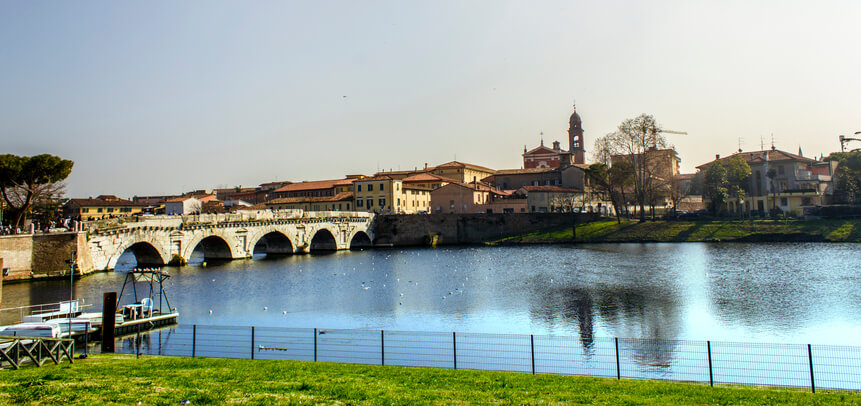Rimini
Rimini City, Italy: A Tourist's Guide to the Enchanting Seaside Town
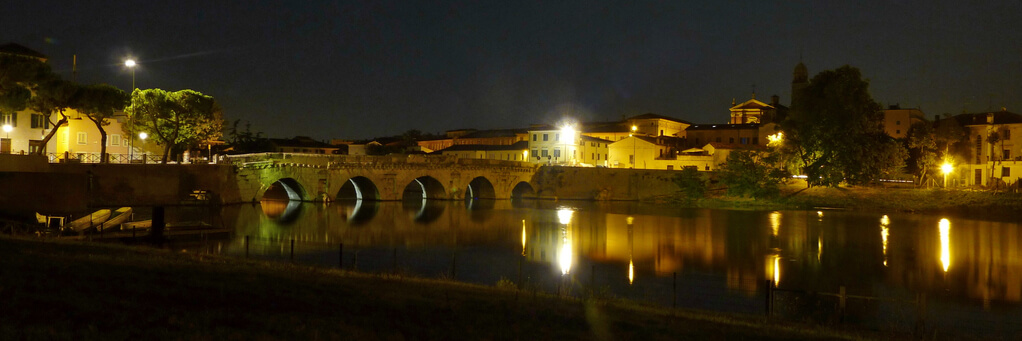
Top Attractions
- Arco d’Augusto (Arch of Augustus)
- Constructed in 27 BC, Arco d’Augusto was named after the first Roman emperor, Caesar Octavian Augustus. Above the arch is an inscription for the emperor and the Roman gods, Jupiter, Apollo, Neptune, and Roma. It is the oldest surviving piece of Roman architecture in northern Italy and marks the entrance to the city from the Flaminia, the ancient route connecting Rome and Rimini. It is located in Corso d’ Augusto, only 5 minutes away from Piazza Tre Martiri.
- Piazza Tre Martiri (Three Martyrs Square)
- Rimini’s historical square, the Piazza Tre Martiri, is home to the 16th-century statue of Julius Caesar, a memorial for when he said the famous phrase, “The die is cast.” The square is surrounded by ancient Roman architecture, as well as shops, restaurants, and cafes where you can sit and relax while touring the city. At its southern part, you will find the 16th-century church Tempietto di Sant Antonio and the Torre dell’Orologio clock tower. It’s a perfect place to eat and drink while admiring the city’s landscape.
- Ponte di Tiberio (Tiberius Bridge)
- Started by Augustus in 14 A.D. and completed by Tiberius in 21 AD, the Ponte di Tiberio is a stunning five-arched bridge that marked the start of the Via Emilia, the ancient road connecting the Adriatic Coast and the Po river valley. The bridge is made of Istrian limestone and spreads to a total length of 70 meters. Today, it connects Rimini’s city center to Borgo San Giuliano hamlet and despite its age, remains to be in good condition, allowing passage for pedestrians, cyclists, and vehicles.
- Tempio Malatestiano (Malatesta Temple)
- Originally a Gothic-style Cathedral, the building was converted into the tomb for Isotta degli Atti, mistress of the lord of Rimini, Sigismondo Malatesta in the mid-1400s. Sigismondo sought the help of architect Leon Battista Alberti to transform the cathedral into a Renaissance masterpiece. Today, it is home to 15th-century artifacts, including the Crocifisso di Giotto (Giotto’s Crucifix), sculptures done by Agostino di Duccio, and the Sigismondo Pandolfo’s sepulcher.
- Castel Sismondo (Sismondo Castle)
- Sismondo Castle, built by the Rimini ruler himself, Sigismondo Pandolfo Malatesta, used to be a majestic fortified palace strategically chosen for the city’s defense. Filippo Brunelleschi, one of the pioneers of Renaissance architecture, was called to help with the castle’s construction. Remains of the original structure can still be seen today and the inscription and coat of arms of the Malatesta are still etched in the entrance portal.
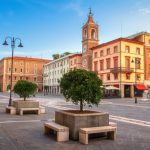
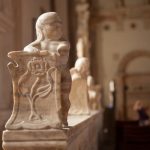
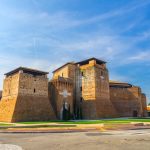
Must-Visit Places in Rimini
- Arco d’Augusto (Arch of Augustus)
- Situated in the heart of the city, it was built in 27 BC by Tiberius in honor of emperor Augustus. It is one of the best-preserved Roman monuments and has served as a model to many other arches across Europe.
- The arch’s current name comes from an erroneous reconstruction carried out during an excavation nearby which led people to believe that it was dedicated to Emperor Gustav II Adolf of Sweden, who happened to visit Rimini in the 17th century.
- Duomo di Rimini (Rimini Cathedral)
- This majestic church dates back to 1295, but several changes have been made over time. The lower part resembles more an ancient fortress than a cathedral, while on top, you can see baroque-style decorations with several bell towers and a dome.
- Ponte di Tiberio (Tiberius’ Bridge)
- Situated along the city’s northern walls, it is one of three bridges that connect the historical center to the surrounding areas of San Giuliano and San Marino. It was built in 27 BC by Tiberius himself to allow easy access from his summer residence to the sea, which at that time was located outside Rimini’s borders. It is also known as Ponte di Rema/Remo because boats were tethered on either bank.
- Rimini is a perfect holiday destination that can cater to all sorts of needs. Whether you are looking for culture and nightlife or just want to relax on the beach, Rimini has something for everyone.
- There are extravagant restaurants and clubs in this city to suit every taste and budget, yet if you want something different, relaxing, and off the beaten path, we would recommend a visit to these five amazing places:
- Arco d’Augusto (Arch of Augustus)
- Situated in the heart of the city, it was built in 27 BC by Tiberius in honor of emperor Augustus. It is one of the best-preserved Roman monuments and has served as a model to many other arches across Europe.
- The arch’s current name comes from an erroneous reconstruction carried out during an excavation nearby which led people to believe that it was dedicated to Emperor Gustav II Adolf of Sweden, who happened to visit Rimini in the 17th century.
- Duomo di Rimini (Rimini Cathedral)
- This majestic church dates back to 1295, but several changes have been made over time. The lower part resembles more an ancient fortress than a cathedral, while on top, you can see baroque-style decorations with several bell towers and a dome.
- Ponte di Tiberio (Tiberius’ Bridge)
- Situated along the city’s northern walls, it is one of three bridges that connect the historical center to the surrounding areas of San Giuliano and San Marino. It was built in 27 BC by Tiberius himself to allow easy access from his summer residence to the sea, which at that time was located outside Rimini’s borders. It is also known as Ponte di Rema/Remo because boats were tethered on either bank.
- Malatestiano Temple
- A perfect example of gothic architecture, the temple was built in honor of Guido Correggio’s wife, who died giving birth to their child. A similar building can be found in Siena, and although it is not known which one influenced the other, the similarities are remarkable.
- Rocca di Ravaldino
- This 13th-century fortress stands on a hill overlooking several historical centers and has been recently restored by local authorities. The main tower is surrounded by three walls that link up with other towers from where you can enjoy views of the whole city. We would recommend visiting it early morning or late afternoon when the streets below are less crowded.
- Arco d’Augusto (Arch of Augustus)
- Malatestiano Temple
- A perfect example of gothic architecture, the temple was built in honor of Guido Correggio’s wife, who died giving birth to their child. A similar building can be found in Siena, and although it is not known which one influenced the other, the similarities are remarkable.
- Rocca di Ravaldino
- This 13th-century fortress stands on a hill overlooking several historical centers and has been recently restored by local authorities. The main tower is surrounded by three walls that link up with other towers from where you can enjoy views of the whole city. We would recommend visiting it early morning or late afternoon when the streets below are less crowded.
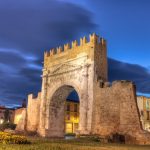
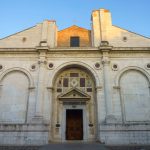
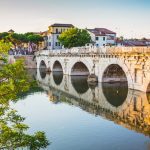
The people of Rimini are very proud of their history and the past of the city, which has always been linked to culture, arts, and entertainment. Today, visitors can still see this by visiting some historical buildings that remain symbols of its many traditions.
The culture is also alive today through traditional events that take place every year throughout the summer season, such as the “Coastal Film Festival,” “Medieval Madness,” and “Festival Della Creatività,” held in August on the occasion of San Bartolomeo.
It’s not hard to understand why Rimini has always been linked to entertainment, art, and history if you take a look at its rich past. The city was once the location where Julius Caesar spent his summer holidays with his family (54-51 BCE) and decided to build an important villa on the seafront, which is still visible today.
At that time, it was called “Ariminum,” meaning high hill in Latin, due to its excellent position, which allowed the city inhabitants to have close contact with other cultures while enjoying all the benefits of being right next to the sea.
This also included trading routes that linked Rimini with regions far beyond Europe, such as China or India. Once the Romans had expanded to the south, Rimini became a very important commercial port.
The city’s history is also linked to many famous figures from ancient times, such as Pliny the Elder and Pliny the Younger, who died in the eruption of Mount Vesuvius in 79 AD while trying to save people from certain death.
The great natural disaster caused great damage but didn’t stop Rimini from developing into a flourishing town that was notable for its advanced infrastructure and sophisticated culture. This included theatres, aqueducts, roads, and a harbor that facilitated access to the sea to facilitate trade.
The Place to Be
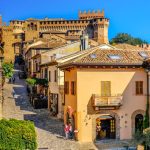
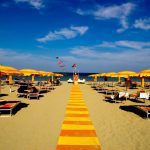
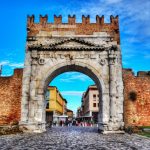
Conclusion
